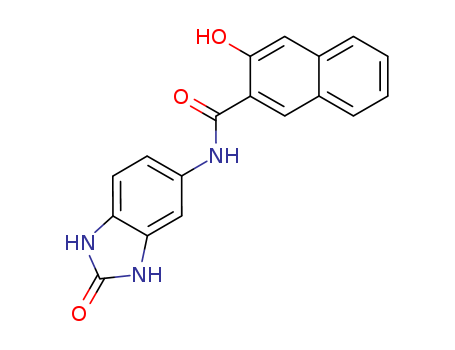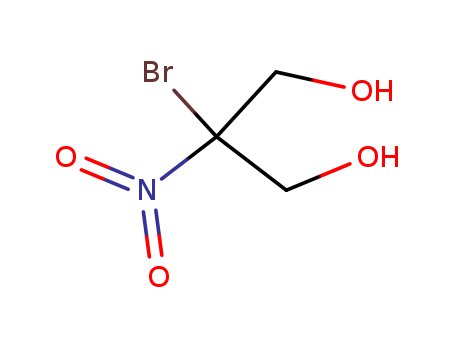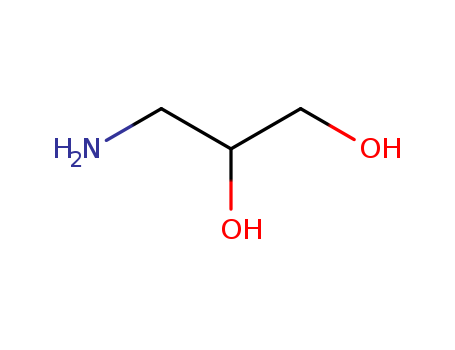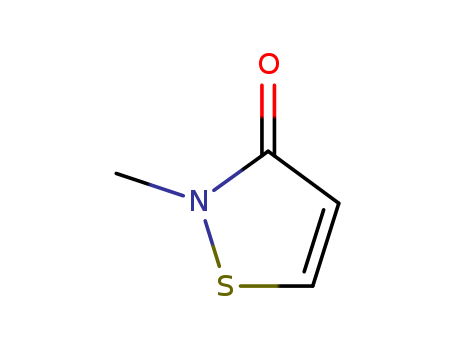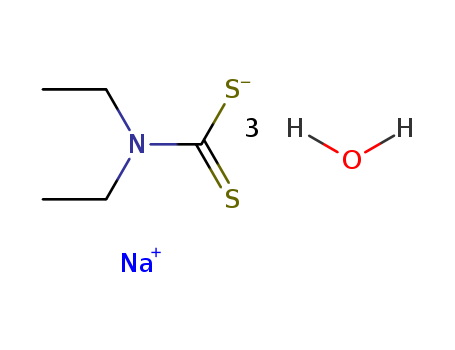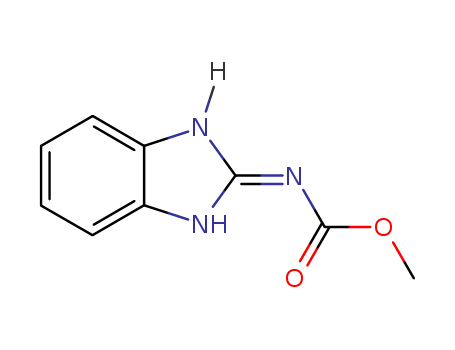
10605-21-7
- Product Name:Carbendazim(CBM)
- Molecular Formula:C9H9N3O2
- Purity:99%
- Molecular Weight:191.189
Product Details;
CasNo: 10605-21-7
Molecular Formula: C9H9N3O2
Appearance: light gray or beige powder
Quality Factory Sells Top Purity 99% Carbendazim(CBM) 10605-21-7 with Safe Delivery
- Molecular Formula:C9H9N3O2
- Molecular Weight:191.189
- Appearance/Colour:light gray or beige powder
- Vapor Pressure:1.5 x 10-4 Pa (25 °C)
- Melting Point:>300 °C(lit.)
- Refractive Index:1.654
- Boiling Point:409oC
- PKA:4.48(at 25℃)
- Flash Point:11 °C
- PSA:67.01000
- Density:1.421 g/cm3
- LogP:1.81420
Carbendazim(Cas 10605-21-7) Usage
|
Definition |
ChEBI: A member of the class of benzimidazoles that is 2-aminobenzimidazole in which the primary amino group is substituted by a methoxycarbonyl group. A fungicide, carbendazim controls Ascomycetes, Fungi Imperfecti, and Basidiomy etes on a wide variety of crops, including bananas, cereals, cotton, fruits, grapes, mushrooms, ornamentals, peanuts, sugarbeet, soybeans, tobacco, and vegetables. |
|
General Description |
Light gray or beige powder. |
|
Air & Water Reactions |
Insoluble in water. Carbendazim slowly decomposes in alkaline solution. . |
|
Reactivity Profile |
Carbendazim is a carbamate ester-amine. Amines behave as chemical bases. Carbamates are chemically similar to, but more reactive than amides. Like amides they form polymers such as polyurethane resins. Carbamates are incompatible with strong acids and bases, and especially incompatible with strong reducing agents such as hydrides. Flammable gaseous hydrogen is produced by the combination of active metals or nitrides with carbamates. Strongly oxidizing acids, peroxides, and hydroperoxides are incompatible with carbamates. |
|
Health Hazard |
ACUTE/CHRONIC HAZARDS: When heated to decomposition Carbendazim emits toxic fumes of NOx. |
|
Fire Hazard |
Literature sources indicate that Carbendazim is probably nonflammable. |
|
Agricultural Uses |
Fungicide: Carbendazim is a systemic fungicide used as a drench to control a broad range of fungi in cereals, vegetables, oilseed rape, sugar beets, grapes, tomatoes, pome fruit and stone fruit. It is also used in post-harvest storage and as treatment in seed pre-planting, frequently in combination with other fungicides. In some areas, it has been used to combat Dutch elm disease. |
|
Trade name |
ABACOL?; AIMCOZIM; BAS? 3460; BAS? 67054; BATTAL?; BAVISTIN?; BENDAZIM?; CARBATE?; CARBENDAZIME?; CARBENDAZOL?; CARBENDAZOLE?; CARBENDAZYM?; CARBENDOR; CEKUDAZIM?; CORBEL; CTR? 6669; CUSTOS?; DEFENSOR?; DELSENE?; DEROSAL?; E-965?; DERROPRENE?; EQUITDAZIN?; FUNGISOL?; HOE 17411?; LIGNASAN?; IMISOL?; KEMDAZIN?; MERGAL?; PILLARSTIN?; POLYPHASE?; RODAZIM?; STEMPOR?; SUPERCARB, TRITICOL?; TRITICOL?; U-32.104? |
|
Biochem/physiol Actions |
B-cell maturation antigen (BCMA) or tumor necrosis factor receptor superfamily member 17 (TNFRSF17) plays an important role in B cell development, function and regulation. BCMA also has the capability to activate nuclear factor-κB (NF-κB), janus kinase (JNK) and mitogen activated protein kinases (MAPKs). The protein is expressed in certain cancers like glioblastoma, chronic lymphocytic leukemia, Hodgkin lymphoma and multiple myeloma. It has a role in the maintenance of survival of long-lived plasma cells in bone marrow. |
|
Safety Profile |
Moderately toxic by skin contact. Mildly toxic by ingestion. An experimental teratogen. Experimental reproductive effects. Human mutation data reported. An agricultural chemical and pesticide. When heated to decomposition it emits toxic fumes of NOx. See also CARBAMATES. |
|
Potential Exposure |
Carbendazim is a benzimidazole/carbamate systemic fungicide used as a drench to control a broad range of fungi in cereals, vegetables, oilseed rape, sugar beets, grapes, tomatoes, pome fruit, and stone fruit. It is also used in postharvest storage and as treatment in seed preplanting, frequently in combination with other fungicides. In some areas, it has been used to combat Dutch Elm disease. |
|
Metabolic pathway |
When the mites are exposed to 14C-carbendazim, the major carbendazim metabolite identified in the bulb mites is 5-hydroxy-2-aminobenzimidazole. Low levels of 2-aminobenzimidazole and 5-hydroxy-2- benzimidazole carbamate are also identified. |
|
Shipping |
UN3082 Environmentally hazardous substances, liquid, n.o.s., Hazard class: 9; Labels: 9-Miscellaneous hazardous material, Technical Name Required |
|
Degradation |
Carbendazim (MBC, 1) was stable in acidic and neutral solutions (pH 5-7, DT50≥57 days at 22°C), but decomposed rapidly with a DT50 of 22 days (WHO, 1993b) to yield 2-aminobenzimidazole (2, Watluns, 1976; Zbozinek, 1984) under alkaline conditions (pH 9). An increase in the salinity of the water accelerated the degradation rate of MBC in water (Deshpande and Patil, 1987). Photolysis of MBC in natural sunlight is not a significant dissipation mechanism in the environment. Significant degradation did not occur either on leaf surfaces exposed to natural sunlight or in unamended dilute aqueous solution. Degradation occurred in solution under natural sunlight if photoinitiators such as riboflavin or acetone were present (Fleeker and Lacy, 1977). |
|
Incompatibilities |
Carbamates are incompatible with reducing agents, strong acids, oxidizing acids, peroxides, and bases. Contact with active metals or nitrides cause the release of flammable, and potentially explosive, hydrogen gas. |
|
Waste Disposal |
Do not discharge into drains or sewers. Dispose of waste material as hazardous waste using a licensed disposal contractor to an approved landfill. Consult with environmental regulatory agencies for guidance on acceptable disposal practices. Incineration with effluent gas scrubbing is recommended. Containers must be disposed of properly by following package label directions or by contacting your local or federal environmental control agency, or by contacting your regional EPA office. |
InChI:InChI=1/C9H9N3O2/c1-14-12-9(13)8-10-6-4-2-3-5-7(6)11-8/h2-5H,1H3,(H,10,11)(H,12,13)
10605-21-7 Downstream products
-
6306-71-4
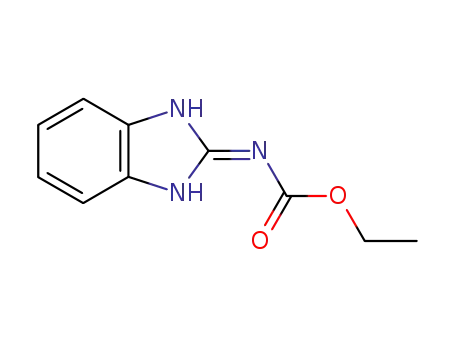
N-(2-benzimidazolyl)-O-ethyl carbamate
Relevant Products
-
5-(2′-Hydroxy-3′-Naphthamide)-2-Benzimidazolone
CAS:26848-40-8
-
Sodium Diethyl Dithiocarbamate(SDEC)
CAS:20624-25-3

